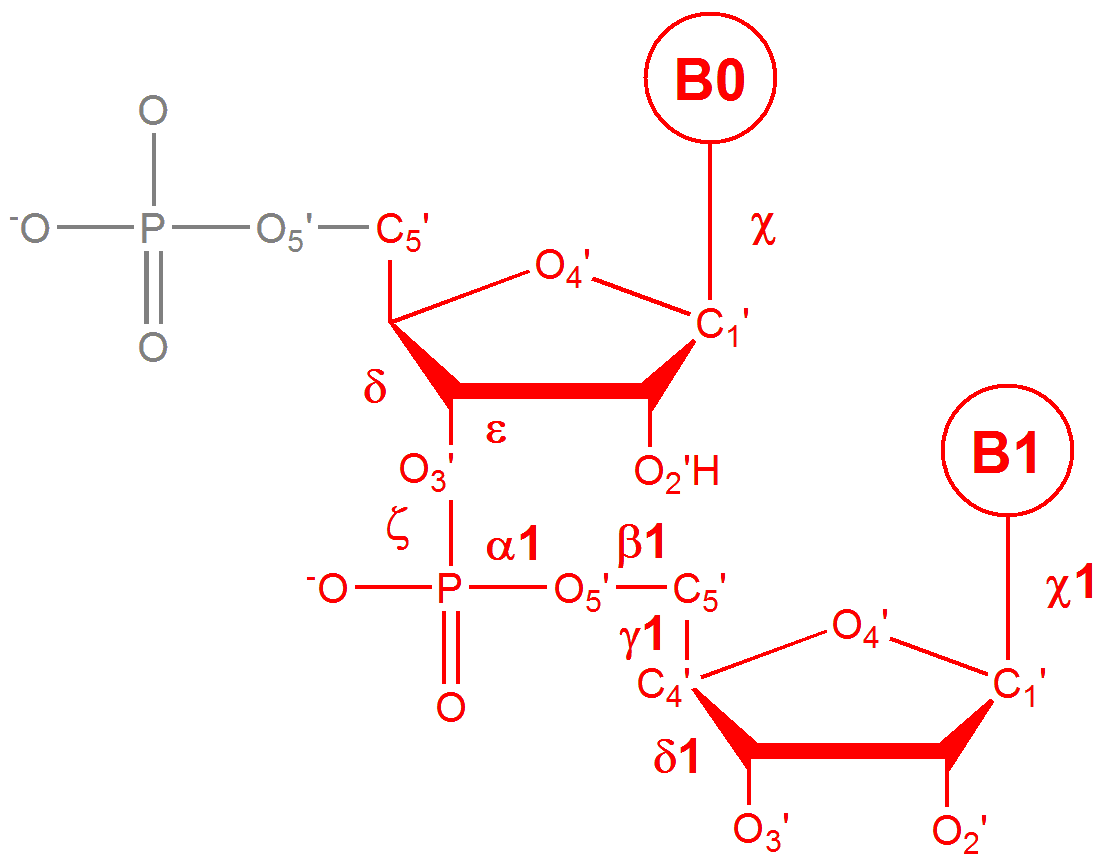| CANA | NtC | Annotation | δ | ε | ζ | α1 | β1 | γ1 | δ1 | χ | χ1 | count
|
| AAA |
AA00 |
The most frequent, "canonical" A-DNA (identical to A-RNA) |
83 |
206 |
287 |
293 |
174 |
55 |
83 |
199 |
202 |
296 |
| AAA |
AA01 |
A-DNA with α1/γ1 crank (150/180) |
82 |
194 |
291 |
149 |
193 |
182 |
87 |
205 |
188 |
55 |
| AAA |
AA02 |
A-DNA with BI-like χ/χ1 |
88 |
203 |
275 |
294 |
161 |
54 |
88 |
244 |
245 |
168 |
| AAA |
AA03 |
A-DNA similar to AA01, high α1 |
83 |
214 |
273 |
330 |
165 |
26 |
86 |
202 |
215 |
9 |
| AAA |
AA04 |
A-DNA similar to AA01, low α1 |
80 |
198 |
301 |
255 |
175 |
91 |
83 |
202 |
192 |
14 |
| A-B |
AB01 |
A-to-B: δ C3'-endo, δ1 C2'-endo, χ/χ1 have A/B pattern |
86 |
193 |
283 |
299 |
180 |
55 |
142 |
221 |
255 |
100 |
| A-B |
AB02 |
A-to-B: δ~O4'-endo, extremely low ε, χ/χ1 are B-like |
92 |
61 |
59 |
208 |
185 |
64 |
133 |
237 |
253 |
18 |
| A-B |
AB03 |
A-to-B: similar to AB01 with high α1 and low ζ, β1, γ1 |
96 |
195 |
253 |
344 |
151 |
33 |
131 |
220 |
250 |
11 |
| B1A |
BA01 |
BI-to-A complex conformer with δ1 from C3' to O4'-endo, χ/χ1 are B-like |
133 |
190 |
259 |
292 |
169 |
51 |
89 |
247 |
230 |
54 |
| B1A |
BA05 |
BI-to-A complex conformer with δ1 from C3' to O4'-endo, χ/χ1 are B-like |
130 |
184 |
266 |
295 |
171 |
53 |
101 |
249 |
235 |
107 |
| B1A |
BA08 |
B-to-A: β1~120, χ1 A-like |
141 |
212 |
188 |
302 |
129 |
55 |
85 |
271 |
211 |
12 |
| B1A |
BA09 |
BI-to-A: β1~60, α1/γ1 crank (250/170), χ1 A-like |
135 |
199 |
287 |
254 |
71 |
168 |
86 |
265 |
187 |
13 |
| B1A |
BA10 |
B-to-A complex cluster: α1~100, γ1~180, χ1 A-like |
135 |
201 |
217 |
103 |
229 |
195 |
88 |
258 |
195 |
43 |
| B2A |
BA13 |
BII-to-A complex cluster: α1~60, γ1~180, χ1 A-like |
142 |
231 |
197 |
74 |
232 |
197 |
89 |
266 |
199 |
57 |
| B2A |
BA16 |
BII-to-A: χ1 A-like |
145 |
255 |
187 |
63 |
226 |
196 |
87 |
260 |
201 |
7 |
| B2A |
BA17 |
BII-to-A: δ1~O4'-endo, β1~120 |
148 |
255 |
177 |
294 |
130 |
44 |
96 |
272 |
234 |
27 |
| BBB |
BB00 |
The most frequent DNA conformer, "canonical" B form, also called BI |
138 |
183 |
259 |
303 |
180 |
44 |
138 |
252 |
258 |
1,958 |
| 2B1 |
BB01 |
Less populated variant of BI form |
132 |
181 |
265 |
301 |
177 |
49 |
121 |
248 |
244 |
142 |
| 3B1 |
BB02 |
BI with α1/γ1 crank (30/300) |
140 |
194 |
246 |
32 |
194 |
297 |
150 |
252 |
253 |
134 |
| 3B1 |
BB03 |
BI with α1/γ1 crank (170/170) |
145 |
176 |
276 |
166 |
164 |
173 |
146 |
239 |
232 |
31 |
| B12 |
BB04 |
BI-to-BII conformer |
140 |
201 |
214 |
315 |
153 |
46 |
140 |
263 |
253 |
243 |
| B12 |
BB05 |
BI-to-BII with α1/γ1 crank (70/230), χ1 A-like |
143 |
220 |
202 |
67 |
231 |
221 |
124 |
268 |
209 |
20 |
| BB2 |
BB07 |
BII form, typical by ε/ζ switch compared to BI |
144 |
245 |
171 |
297 |
141 |
46 |
141 |
270 |
259 |
371 |
| BB2 |
BB08 |
BII form, variant, α1/γ1 crank (60/210) |
142 |
248 |
195 |
64 |
230 |
210 |
142 |
262 |
230 |
19 |
| miB |
BB10 |
B form with extremely low values of α1, β1, γ1 |
139 |
195 |
191 |
23 |
106 |
19 |
129 |
257 |
258 |
49 |
| miB |
BB11 |
B form with α1/γ1 crank (120/180) |
144 |
200 |
199 |
121 |
226 |
189 |
143 |
258 |
222 |
22 |
| miB |
BB12 |
BI with α1/γ1 crank (250/170), low β1 70, χ1 A-like |
140 |
196 |
287 |
248 |
73 |
172 |
144 |
263 |
212 |
18 |
| miB |
BB13 |
BI with α1/γ1 crank (210/160), low β1 100, χ1 A-like |
143 |
186 |
291 |
216 |
104 |
161 |
147 |
252 |
219 |
17 |
| miB |
BB14 |
B-form with extremely low ε |
121 |
104 |
303 |
229 |
260 |
73 |
132 |
264 |
263 |
8 |
| miB |
BB15 |
BI with high α1 and γ1 near 0 |
149 |
187 |
261 |
341 |
192 |
354 |
148 |
250 |
261 |
17 |
| miB |
BB16 |
Complex cluster of B-like conformers: A-like χ, bases may be unstacked to incorporate intercalated drug, occurs where backbone accommodates deformation (metal ion near, strand crossing in Holliday junctions, ends of duplexes) |
145 |
227 |
281 |
288 |
173 |
51 |
142 |
197 |
267 |
117 |
| SQX |
AB1S |
A-to-B-like but χ1 syn, mostly in duplexes |
91 |
214 |
280 |
295 |
176 |
56 |
139 |
238 |
67 |
14 |
| SQX |
BBS1 |
BI-like but χ syn, may be in duplex but many G-G in quadruplexes |
146 |
189 |
275 |
294 |
174 |
52 |
135 |
62 |
261 |
47 |
| SQX |
BB1S |
G-G in quadruplexes, unusual β1, γ1, χ1 syn |
140 |
202 |
282 |
307 |
258 |
304 |
151 |
236 |
65 |
17 |
| SQX |
BB2S |
BI-like but χ1 syn, mostly G-G in quadruplexes, α1 g+, γ1 g- |
137 |
196 |
225 |
33 |
187 |
295 |
145 |
257 |
70 |
8 |
| SQX |
NS1S |
Partially unstacked T-G/G-T in quadruplexes, χ1 syn, unusual ζ, α1, γ1 |
143 |
206 |
61 |
82 |
204 |
192 |
146 |
242 |
68 |
13 |
| SQX |
NS02 |
Start of loop in quadruplex or hairpin, G-X, untypical ζ, α1, γ1 |
145 |
225 |
67 |
74 |
189 |
191 |
137 |
264 |
258 |
14 |
| SQX |
NS03 |
Partially unstacked T-T in quadruplexes, unusual combination of ε, ζ, α1, γ1, χ1 |
143 |
294 |
111 |
153 |
197 |
53 |
151 |
262 |
185 |
13 |
| SQX |
NS04 |
Unstacked, in 4-way junction, ε, ζ high values |
140 |
275 |
279 |
304 |
191 |
56 |
150 |
266 |
210 |
12 |
| SQX |
NS05 |
5'-end of dsDNA, base open (unstacked), ζ, α1 ~60 |
154 |
242 |
77 |
63 |
177 |
64 |
137 |
237 |
249 |
10 |
| ZZZ |
ZZ1S |
Z form, Y-R step |
148 |
264 |
76 |
66 |
186 |
179 |
95 |
205 |
60 |
20 |
| ZZZ |
ZZ2S |
Z form, Y-R step, δ1 C2'-endo |
141 |
263 |
71 |
78 |
179 |
185 |
148 |
208 |
77 |
41 |
| ZZZ |
ZZS1 |
ZI form, R-Y step |
97 |
242 |
294 |
209 |
230 |
55 |
144 |
63 |
205 |
48 |
| ZZZ |
ZZS2 |
ZII form, R-Y step |
95 |
186 |
63 |
169 |
162 |
44 |
144 |
58 |
213 |
17 |

